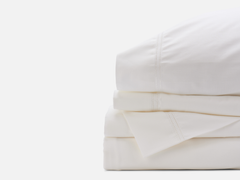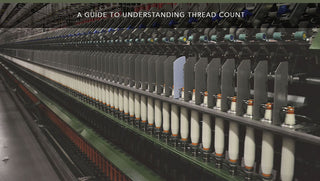When we discuss sheets, thread count generally comes to the forefront of the conversation. Unfortunately, there's a ton of misinformation out there regarding this. The propagated myth is that sheets with a high thread count are somehow better; this is a much more complex situation. Thread count is only part of the equation. Luckily, we have you covered. Check out our guide to understanding thread count below.
What Is Thread Count?
Thread count is the measure of the number of threads that are woven into a square inch of fabric. Yarn is typically woven in a crisscross pattern. We refer to vertical strands as warp weaves and horizontal pieces are weft weaves. When you add the weft and warp yarns, you get the total number—i.e., the thread count. Generally, you want sheets between the 130-400 thread count range. Anything less will feel like sandpaper against your skin. That is hardly the effect you were looking for, right?
How Can Thread Count Mislead Consumers?
High thread count sheets have a problem: retailers take advantage of the assumption that high thread counts equal quality cotton and manufacturing processes. You can have poor quality, high thread count sheets; other factors play a role in how good or bad the quality of your sheets is. Your 1000 thread count sheets aren't of exemplary quality because they're 1000. You can have comfortable and cozy sheets that are below 200 thread count.
Is High Thread Count Better?
Not necessarily. It certainly matters, but we must alter our understanding of its importance. You need to consider this with the quality of cotton, whether single or multi-ply, and the type of weave. 100-200 thread count sheets are crisp and light if you want something lightweight. You'll feel like you're sleeping on clouds. It's necessary to understand this in our guide to thread count.
Other factors make a huge difference. Some retailers will try to take advantage of the myth that a high thread count immediately equals greater comfort and increase the price tag. Don't get fooled. A higher price doesn’t mean a comfortable sheet.
What Makes a High-Quality Sheet?
Measuring thread count should be one of many factors you consider when shopping for high-quality sheets. To determine the quality, you'll need to look at a given sheet staple length, weave pattern, and fibers. You must weigh those factors alongside the thread count of the fabric. All these things affect your sheets' durability, appearance, and feel. After considering all those things, you'll have an overall idea of the quality of the sheets you're thinking of buying.
Single Ply
Single-ply threads are the most durable and breathable cotton sheets on the market. To use poor-quality short-staple cotton, manufacturers sometimes use multi-ply yarns. This makes your bedding more dense, far less comfortable, and less durable. Choose single-ply threads instead. You'll feel the difference immediately.
Location, Location, Location
Where threads are woven can also significantly impact how your bedding feels on your skin. While many factories are in Portugal or Italy, Red Land Cotton manufactures our products directly in the United States, where we grow our cotton on a family farm deep in Alabama! If you want to support an American-based company that makes luxury cotton bedding and towels made in the USA, we have you covered.
Fabric Fiber
Fabric fiber is the material that makes up your sheets. Some common choices from other retailers include bamboo, silk, and linen. That said, these fabrics pale in comparison to cotton. Satin traps heat, bamboo costs more than cotton, and the chemical processing often causes people with sensitive skin to break out. Silk is expensive, easy to wrinkle, and difficult to care for. Since this is the case, what exactly do you do? How do you find satisfaction in a market saturated with products ill-equipped to address your unique needs?
While there are many fibers on the market, cotton is the best choice. Our sheets at Red Land Cotton are durable, crisp, and all-natural for the perfect luxurious look and feel. Cotton is an incredibly breathable material. This means that it keeps you warm in winter and cool in summer. Chills and sweating at night will be a thing of the past. It's hypoallergenic and perfect for people with sensitive skin and allergies.
High-quality cotton is a luxury that will leave you feeling cozy all day and night. You won't want to leave your bed! Because of this, we can't emphasize how crucial high-quality cotton sheets are to your quality of life. Don't just get any cotton bedding. Shop Red Land Cotton today.
Staple Length
Staple length is the length of the fibers that you use to create a fabric like cotton. Generally, they come in short, long, and extra-long. The longer the staple length, the softer the fabric. Extra-long and long staple lengths are generally of higher quality. They're most often used for bedding, given how soft they feel against your skin.
They're durable but light and smooth. On the other hand, short-staple fabrics are thick and rough. To give you an idea of the texture, you see them used a lot for denim, T-shirts, and towels. Because of this, it's important that you stick with long or extra-long staple lengths for your sheets.
Fabric Construction
The two most popular kinds of fabric construction are percale and sateen. Bedding manufacturers create percale sheets using a plain weave technique of "one thread over one thread," while sateen sheets have four threads over one thread to create a perfect satin weave. Percale sheets are matte in appearance and crisp. They're also incredibly breathable. That said, sateen sheets are smooth as silk to the touch, are wrinkle-resistant, and have a mild sheen. However, they do tend to be less durable than percale sheets.
Here at Red Land Cotton, we don’t use any cheap gimmicks. We boast the crispest, most luxurious bedding money can buy. All our bedsheets come at 140 thread count. We boast all-natural cotton in all of our products. If you want the best, shop Red Land Cotton today!



